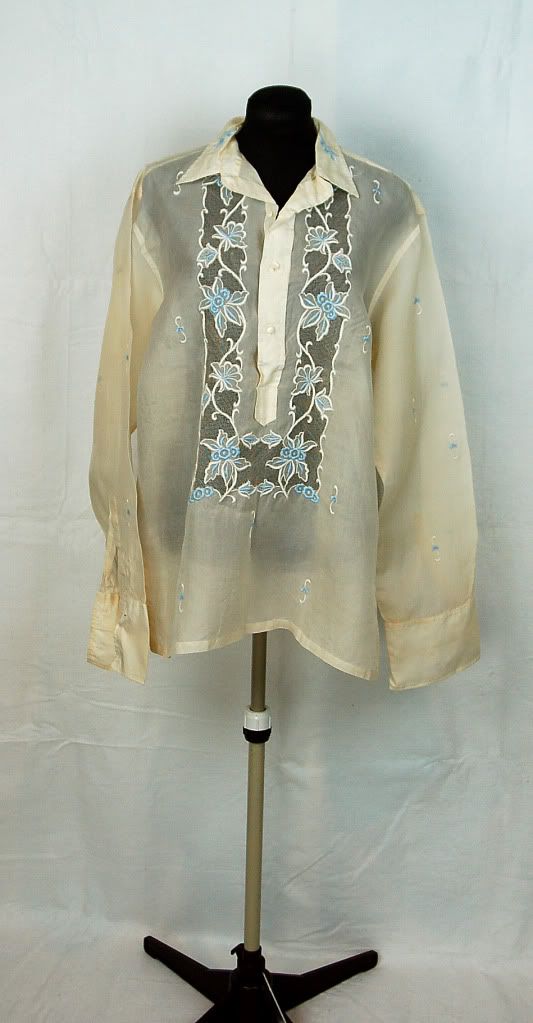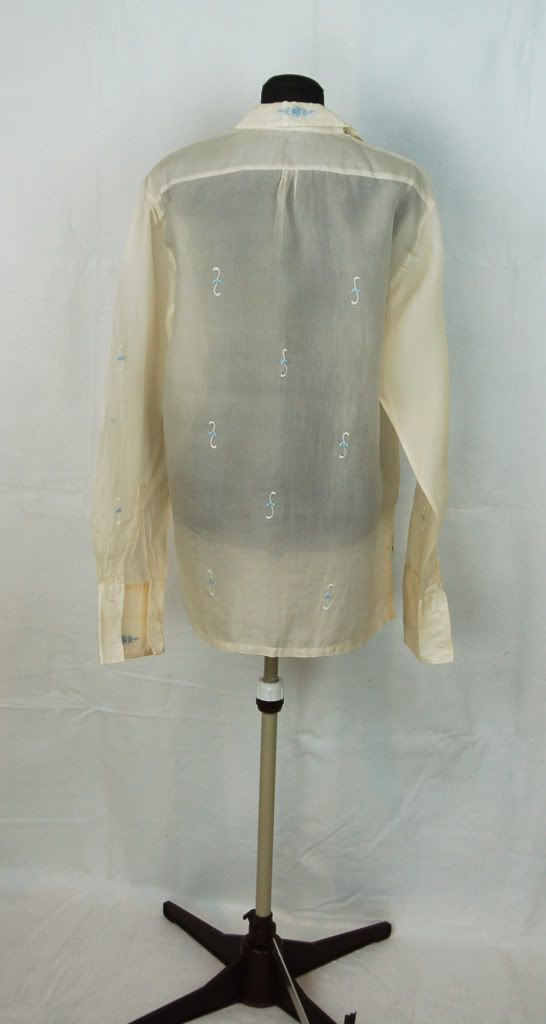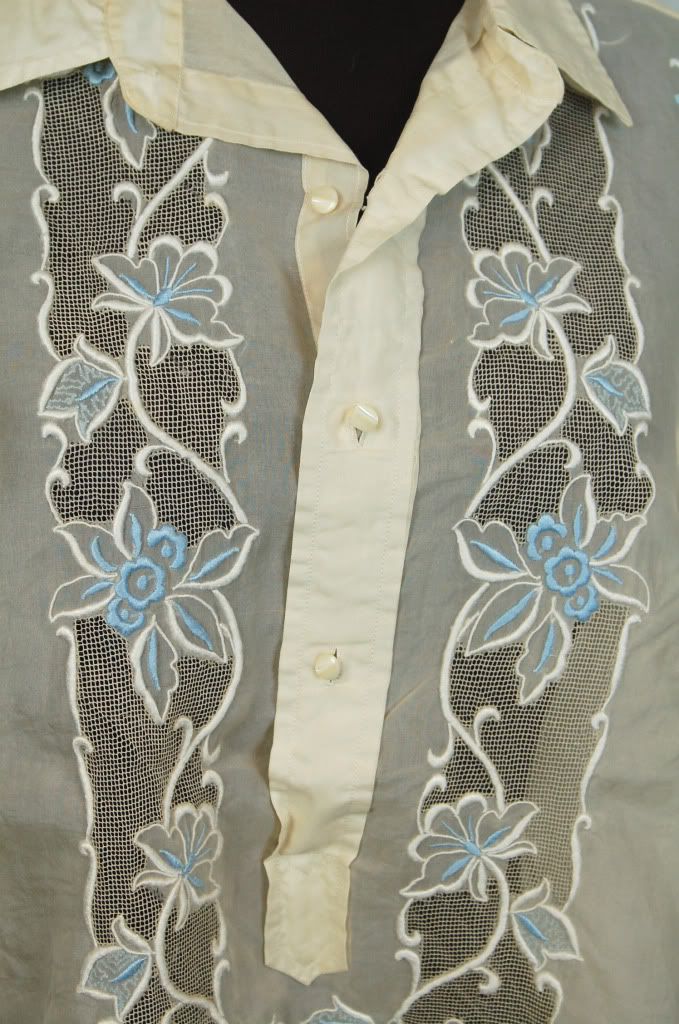Navigation
Install the app
How to install the app on iOS
Follow along with the video below to see how to install our site as a web app on your home screen.
Note: This feature may not be available in some browsers.
More options
You are using an out of date browser. It may not display this or other websites correctly.
You should upgrade or use an alternative browser.
You should upgrade or use an alternative browser.
Is this a barong Tagalog? is the fabric banana or pineapple?
- Thread starter zannew
- Start date
This certainly looks like a barong tagalog to me. Looks like I was on the right track with the other piece, if they both came from the same estate.
As far as discerning between the fabrics, I think it is a tough call without actually handling it, as they are similar.
As far as discerning between the fabrics, I think it is a tough call without actually handling it, as they are similar.
I think it is from the 60s or perhaps the very early 70s. I think most of these items were made from the more exotic fabrics.
I have two of these & they are definitely from the Philippines. Mine were in storage for a long time & finally shattered. They are some type of natural fiber but I don't think they are silk, although the burn test suggested silk. I have been saving them for the appliqués, hoping to repurpose them.
Just curious but do you know how you would test to see if they were the pineapple or banana fibre, MS?
I have had some before, probably still do hiding somewhere and I always thought they were silk organdy as well but now I am wondering.
I have had some before, probably still do hiding somewhere and I always thought they were silk organdy as well but now I am wondering.
This is definitely a barong tagalog and it is typically made from pina, jusi or banana fabric. Pina, in my opinion, is the most fine, as it is hand-loomed from pineapple fibers. Time range...I'd place it at late 70's early 80's. The vintage barong tagalogs made in the 70's have more interesting cuts than the ones they make nowadays. Historically, they were made see-through so that Filipinos could not conceal weapons from the Spanish during the Spanish colonial period. Their Spanish influence explains why these are often confused with guayaberas.
great information, Ibonlaya! welcome to our forums!! 

M
MissRita
Guest
I thought it was a guayabera too, thanks for clarifying that Ibonlaya.
This is definitely a barong Tagalog. The fabric is Jusi...probably from the 70's if not 60's. Blue embroidery was common in this decade and the netting embroidery is called "calado" - a painstaking hand craft done by counting, cutting, and stitching threads to create a delicate netting in between floral motifs (generally done in Iloilo, Taal, or Bulacan)
bycinbyhand
VFG Member
Very interesting thread!!
bycinbyhand
VFG Member
I thought they were silk too... sure feel like it.Just curious but do you know how you would test to see if they were the pineapple or banana fibre, MS?
I have had some before, probably still do hiding somewhere and I always thought they were silk organdy as well but now I am wondering.
Rue_de_la_Paix
VFG Member
My personal experience with Pina cloth is that is is very very silky, but does not "feel" like silk when you run your fingers over it. Very fine and light. I rarely see any of it these days. It takes a very long time and a lot of human effort to make just 1 yard of it, so most of it was used for special garments for weddings or special occasions, as it is very expensive.
I might guess that your shirt is more likely to be silk or some other fiber. I cannot be sure from a photo, but it does not look like pina cloth to me. It is a bit denser than pina.
I might guess that your shirt is more likely to be silk or some other fiber. I cannot be sure from a photo, but it does not look like pina cloth to me. It is a bit denser than pina.
bycinbyhand
VFG Member
So if it feels like silk it is likely silk not pina?My personal experience with Pina cloth is that is is very very silky, but does not "feel" like silk when you run your fingers over it. Very fine and light. I rarely see any of it these days. It takes a very long time and a lot of human effort to make just 1 yard of it, so most of it was used for special garments for weddings or special occasions, as it is very expensive.
I might guess that your shirt is more likely to be silk or some other fiber. I cannot be sure from a photo, but it does not look like pina cloth to me. It is a bit denser than pina.
Rue_de_la_Paix
VFG Member
Cin,
I wish I could answer your question, but much like color, "feel" can be subjective. The way something feels to one person may vary from another. I just know what something feels like to me after handling so many types of fabrics and fibers over the decades. What is" silky" to one person, may not feel like silk to me. I can only say that if you have even handled pina cloth you just know it has its very own feel to the fingers and to the eye when held to the light. It has a silky feel but has less resistance to the finger tip than silk does.
The workmanship of the garment can be a clue also, as pina would not be used for mass marketed, exported or tourist items sold in the shops. Look for made-to-order garments, and one of kind garments made with expert tailoring and hand stitches, hand finished buttonholes, etc. I might expect a pina garment to have hand embroidery vs. sewn on appliques or machine embroidery, for example.
I wish I could answer your question, but much like color, "feel" can be subjective. The way something feels to one person may vary from another. I just know what something feels like to me after handling so many types of fabrics and fibers over the decades. What is" silky" to one person, may not feel like silk to me. I can only say that if you have even handled pina cloth you just know it has its very own feel to the fingers and to the eye when held to the light. It has a silky feel but has less resistance to the finger tip than silk does.
The workmanship of the garment can be a clue also, as pina would not be used for mass marketed, exported or tourist items sold in the shops. Look for made-to-order garments, and one of kind garments made with expert tailoring and hand stitches, hand finished buttonholes, etc. I might expect a pina garment to have hand embroidery vs. sewn on appliques or machine embroidery, for example.
bycinbyhand
VFG Member
Interesting and food for fodder. Thank you for that information.Cin,
I wish I could answer your question, but much like color, "feel" can be subjective. The way something feels to one person may vary from another. I just know what something feels like to me after handling so many types of fabrics and fibers over the decades. What is" silky" to one person, may not feel like silk to me. I can only say that if you have even handled pina cloth you just know it has its very own feel to the fingers and to the eye when held to the light. It has a silky feel but has less resistance to the finger tip than silk does.
The workmanship of the garment can be a clue also, as pina would not be used for mass marketed, exported or tourist items sold in the shops. Look for made-to-order garments, and one of kind garments made with expert tailoring and hand stitches, hand finished buttonholes, etc. I might expect a pina garment to have hand embroidery vs. sewn on appliques or machine embroidery, for example.



